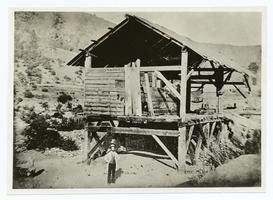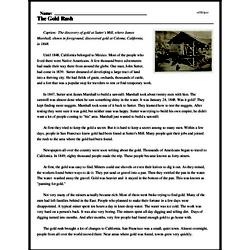The Gold Rush
Caption: The discovery of gold at Sutter's Mill, where James Marshall, shown in foreground, discovered gold at Coloma, California, in 1848.
Until 1848, California belonged to Mexico. Most of the people who lived there were Native Americans. A few thousand brave adventurers had made their way there from around the globe. One man, John Sutter, had come in 1839. Sutter dreamed of developing a large tract of land into a thriving city. He had fields of grain, orchards, thousands of cattle, and a fort that was a popular stop for travelers to rest or find temporary work.
In 1847, Sutter sent James Marshall to build a sawmill. Marshall took about twenty men with him. The sawmill was almost done when he saw something shiny in the water. It was January 24, 1848. Was it gold? They kept finding more nuggets. Marshall took some of it back to Sutter. They learned how to test the nuggets. After testing they were sure it was gold, but neither man was happy. Sutter was trying to build his own empire; he didn't want a lot of people coming to "his" area. Marshall just wanted to build a sawmill.
At first they tried to keep the gold a secret. But it is hard to keep a secret among so many men. Within a few days, people in San Francisco knew gold had been found at Sutter's Mill. Many people quit their jobs and joined the rush to the area where the gold had been found.
Newspapers all over the country were soon writing about the gold. Thousands of Americans began to travel to California. In 1849, eighty thousand people made the trip. These people became known as forty-niners.




